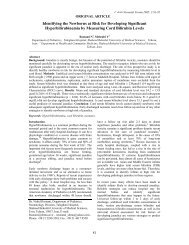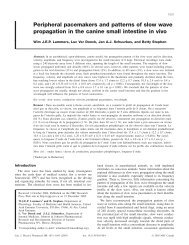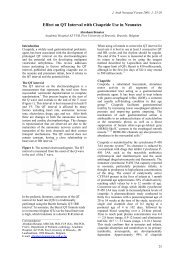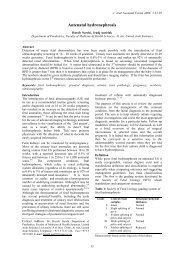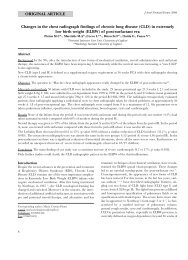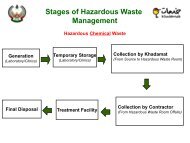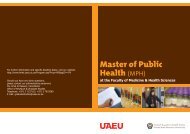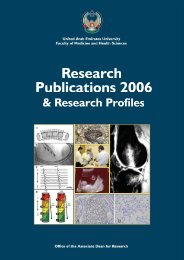Research Profile - College of Medicine and Health Science - United ...
Research Profile - College of Medicine and Health Science - United ...
Research Profile - College of Medicine and Health Science - United ...
You also want an ePaper? Increase the reach of your titles
YUMPU automatically turns print PDFs into web optimized ePapers that Google loves.
Department <strong>of</strong> Pharmacology<br />
subtype selective toxins from mamba snake<br />
(Dendroaspis) venoms. At present the status <strong>of</strong><br />
M1 <strong>and</strong> M4 receptors in health <strong>and</strong> disease<br />
states in humans are being investigated. Our<br />
results show significant decrease <strong>of</strong> M4, but not<br />
<strong>of</strong> M1 receptors in the hippocampus <strong>of</strong><br />
Alzheimer’s patients compared to controls.<br />
Moreover, changes in these receptors in<br />
adrenalectomized animal models which have<br />
been shown to have a selective loss <strong>of</strong><br />
hippocampal neurons. Attempts to isolate <strong>and</strong><br />
characterize M2, M3, <strong>and</strong> M5 selective toxins is<br />
also in progress. Behavioral, biochemical <strong>and</strong><br />
electrophysiological techniques are also used in<br />
underst<strong>and</strong>ing the role <strong>of</strong> other<br />
neurotransmitters in diabetes, epilepsy,<br />
aggressive behavior, aging, <strong>and</strong> degenerative<br />
diseases.<br />
Pr<strong>of</strong>. Georg Petroianu<br />
Clinical toxicology<br />
Therapy <strong>of</strong> acute organophosphate<br />
poisoning<br />
Organophosphorus cholinesterase inhibitors<br />
(organophosphates) are widely used in<br />
agriculture, in industry <strong>and</strong> technology, <strong>and</strong> in<br />
military technology. According to the WHO,<br />
more than one million casualties per year are<br />
due to organophosphates exposure. Countries<br />
<strong>of</strong> the Indian subcontinent <strong>and</strong> adjacent regions<br />
top the list. While use <strong>of</strong> atropine in the therapy<br />
<strong>of</strong> acute organophosphate poisoning is wellestablished<br />
clinical practice, the use <strong>of</strong> oxime<br />
enzyme reactivators (pralidoxime, obidoxime)<br />
is a hotly debated issue. Recent in vivo data<br />
from our laboratory shows that oximes produce<br />
a spurious signal when ChE activity is<br />
determined photometrically. True enzyme<br />
protection/reactivation is thus less than<br />
assumed. Furthermore high dose oxime<br />
increases the “time-to-extubation (TTE)” <strong>and</strong><br />
mortality as compared to identical therapy<br />
without oxime (animal data). The paradigm <strong>of</strong><br />
enzyme reactivation in organophosphate<br />
poisoning must be reassessed <strong>and</strong> alternatives<br />
developed. Screening <strong>of</strong> benzamide<br />
compounds with cholinesterase protective<br />
capabilities is a present priority <strong>of</strong> our group.<br />
Preliminary experiments performed in our<br />
laboratory in vitro <strong>and</strong> in vivo suggest that the<br />
benzamide compound tiapride is partially<br />
protective against esterase inhibition by<br />
organophosphates. In addition newly<br />
synthesized oximes with superior reactivating<br />
properties are tested in conjunction with<br />
benzamides to increase survival in exposed<br />
animals.<br />
Pr<strong>of</strong>. MY Hasan<br />
Neuroscience<br />
The main line <strong>of</strong> research has been focusing on<br />
neurotransmission. We have been applying<br />
behavioral, biochemical <strong>and</strong> electrophysiological<br />
<strong>and</strong> morphological techniques in<br />
underst<strong>and</strong>ing the role <strong>of</strong> neurotransmitters in<br />
various disorders (diabetes, epilepsy, aging,<br />
neurodegenerative diseases). Findings indicated<br />
significant modification <strong>of</strong> specific<br />
neurotransmitters in many <strong>of</strong> the disorders. It<br />
appears that alteration in calcium mobilization<br />
<strong>and</strong> free radical system may be a common factor<br />
accounting for some <strong>of</strong> the changes observed<br />
in aging, diabetes <strong>and</strong> Parkinson's disease.<br />
Another line <strong>of</strong> research has been toxicological<br />
studies <strong>and</strong> impact <strong>of</strong> toxins on muscle the<br />
nervous system. We have investigated the effects<br />
<strong>of</strong> heavy metal intoxication in relation to<br />
FIGURE 1<br />
degenerative diseases. We studied impact <strong>of</strong><br />
heavy metal toxicity on nervous system <strong>and</strong><br />
muscle <strong>and</strong> observed that free radicals may be<br />
involved in metal toxicity <strong>and</strong> antioxidants like<br />
ascorbic acid <strong>and</strong> alpha-tocopherol may have a<br />
protective role against metals effects Also we<br />
have been looking at neurotoxicity <strong>and</strong> general<br />
toxicity from organophosphates <strong>and</strong> nerve<br />
gases. We have been screening antidotes for<br />
organophosphate poisoning <strong>and</strong> implication<br />
for treating exposure to nerve gas agents.<br />
Furthermore my interest covered broad areas in<br />
medical education <strong>and</strong> community health. Some<br />
63




